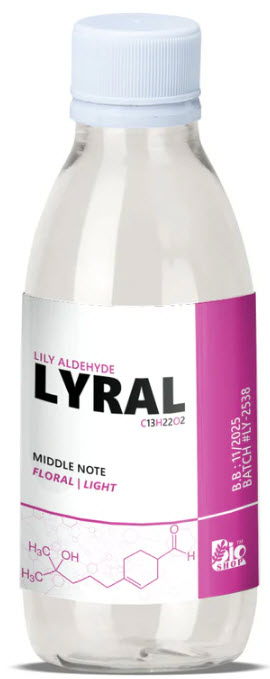Lyral (chemical name: Hydroxyisohexyl 3-cyclohexene carboxaldehyde) is a synthetic aroma chemical widely used in perfumery. It is known for its soft, floral, and slightly green scent, which makes it a popular choice for creating fresh, clean, and modern fragrances. Below is a detailed explanation of Lyral, including its properties, uses, and significance in perfumery.

1. Chemical Structure and Properties
- Chemical Name: Hydroxyisohexyl 3-cyclohexene carboxaldehyde
- IUPAC Name: 4-(4-Hydroxy-4-methylpentyl)cyclohex-3-ene-1-carbaldehyde
- Molecular Formula: C₁₃H₂₂O₂
- Molecular Weight: 210.31 g/mol
- Appearance: A colorless to pale yellow liquid.
- Odor: Soft, floral, lily-of-the-valley-like, slightly green, and clean with a fresh, soapy undertone.
- Solubility: Insoluble in water but soluble in alcohol and oils, making it suitable for use in perfumes and cosmetic formulations.
- Boiling Point: Approximately 300°C (572°F).
- Stability: Stable under normal conditions but can degrade under strong acids, bases, or UV light.
2. Natural Occurrence
Lyral is a synthetic compound and does not occur naturally in significant quantities. It is part of the aldehyde family, a group of chemicals known for their powerful and distinctive scents. Lyral was developed to mimic the scent of lily of the valley (a flower that cannot be directly extracted for its fragrance) and has become a staple in modern perfumery.
3. Role in Perfumery
Lyral is a versatile fragrance ingredient with several key roles:
- Floral Enhancer: It is widely used to create or enhance floral accords, particularly lily-of-the-valley, muguet, and other white floral notes.
- Blending Agent: It harmonizes well with other floral, green, and citrus notes, creating a balanced and modern scent profile.
- Clean and Soapy Note: It adds a fresh, clean, and slightly soapy quality, making it ideal for modern and functional fragrances.
- Fixative: It helps stabilize and prolong the scent of a perfume by slowing down the evaporation of more volatile components.
4. Fragrance Profile
Lyral contributes the following olfactory characteristics to a perfume:
- Floral: Imparts a soft, sweet, and lily-of-the-valley-like floral note.
- Green: Adds a fresh, slightly green, and leafy undertone.
- Clean: Provides a fresh, soapy, and laundry-like quality.
- Soft: Creates a gentle, velvety, and skin-friendly scent.
5. Common Uses in Perfumes
Lyral is a staple in many fragrance families, including:
- Floral Fragrances: It is a key component in floral perfumes, particularly those featuring lily-of-the-valley, muguet, and other white floral notes.
- Fresh Fragrances: Its clean and soapy qualities make it ideal for fresh and modern compositions.
- Functional Fragrances: It is widely used in soaps, detergents, and household cleaners due to its fresh and pleasant scent.
- Oriental Fragrances: It complements the warm, spicy, and sweet notes in oriental perfumes.
6. Safety and Regulation
Lyral has been a subject of regulatory scrutiny due to its potential to cause skin sensitization in some individuals. Key points include:
- IFRA Compliance: The International Fragrance Association (IFRA) has set strict guidelines for the maximum allowable concentration of Lyral in different product types to ensure safety.
- Allergen Potential: It is classified as a potential allergen in the EU, and products containing it must be labeled accordingly if it exceeds certain thresholds.
- Restrictions: Due to its sensitization potential, its use has been restricted or banned in some formulations, particularly in leave-on products like perfumes and lotions.
7. Advantages in Perfumery
- Versatility: It blends well with a wide range of fragrance materials, including florals, greens, and citruses.
- Floral Realism: It effectively mimics the scent of lily of the valley, a flower that cannot be directly extracted for its fragrance.
- Clean and Modern Appeal: Its fresh and soapy qualities make it ideal for modern and functional fragrances.
8. Limitations
- Sensitization Risk: Its potential to cause allergic reactions has led to restrictions on its use.
- Regulatory Restrictions: Compliance with IFRA and EU regulations has limited its use in certain formulations.
9. Example Perfumes Featuring Lyral
Lyral has been used in numerous iconic fragrances, including:
- Dior J’adore: Enhances the white floral bouquet.
- Chanel Chance: Complements the fresh and floral accords.
- Lancôme Trésor: Adds softness and floral depth to the oriental composition.
10. Conclusion
Lyral is a fundamental aroma chemical in modern perfumery, prized for its soft, floral, and clean characteristics. Its ability to mimic the scent of lily of the valley and enhance floral accords makes it indispensable in creating fresh, modern, and elegant fragrances. However, its potential as a sensitizer has led to regulatory restrictions, necessitating careful formulation and adherence to safety guidelines. Despite these challenges, its versatility and unique scent profile ensure its continued prominence in the fragrance industry.